DCS AH-64D Apache: Sight Source and Acquisition Source
This DCS AH-64D Apache guide page explains what the sight and acquistion source is and how the SLAVE function works. How to set sight and acqisition for pilot and CPG? Sight and acquisition on HMD and TADS.
Last update:
Sight and acquisition sources are the crucial term while searching for targets. This page of DCS: AH-64D Apache simulator guide explains what is the sight source and the acquisition source. We explain the differences between them and suggest how to use them properly during combat missions. We also describe the SLAVE function in the TADS system and its connection to acquisition source.
- Sight Source and Acquisition Source - what are they?
- "SLAVE" button
- TADS as Gunner Helmet Sight
- Acquisition Source in the pilot's cockpit
Sight Source and Acquisition Source - what are they?
Before you start learning how to use weapons systems and search for targets, it is worth familiarizing yourself with the concepts of "sight source" and "acquisition source", the relation between them and how to use them effectively in combat.
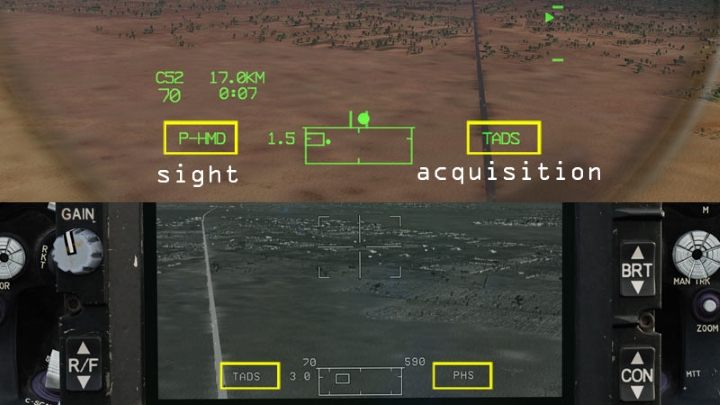
The selected sight and acquisition sources can always be seen on the IHADSS and the TADS display. On the left of the screen there is an active sight, on the right - an active acquisition source.
If you are familiar with other DCS modules like F-16C, F/A-18C or AV-8B Harrier, it will be easy to compare sight source to SOI (Sensor of Interest) in those aircraft, and acquisition source to SPI (Sensor Point of Interest). The US Army simply uses different terms here.
To be more precise, a "sight source" is a device that is currently used for aiming at target or searching for targets. These can be the following sensors:
- P-HMD (Pilot Helmet Mounted Display) - pilot's helmet sight
- C-HMD (CPG Helmet Mounted Display) - CPG's helmet sight
- TADS (Target Acquisition and Designation System) - only in CPG's cockpit
- FCR (Fire Control Radar) - Longbow radar (in the current version of early access it is not available)
Acquisition source is a designated location or map point that the sight can automatically track or aim at. These can be the following:
- PHS (Pilot Helmet Sight) - the point at which the pilot is currently looking with his helmet sight
- GHS (Gunner Helmet Sight) - the point at which the CPG is currently looking with its helmet sight
- TADS - the location/object indicated by the TADS crosshair
- SKR (Seeker) - object tracked by the Hellfire missile sensor. This source is used only when another unit illuminates a target with laser.
- FXD (Fixed) - a fixed point directly in front of the helicopter
- ?00 - selected map point
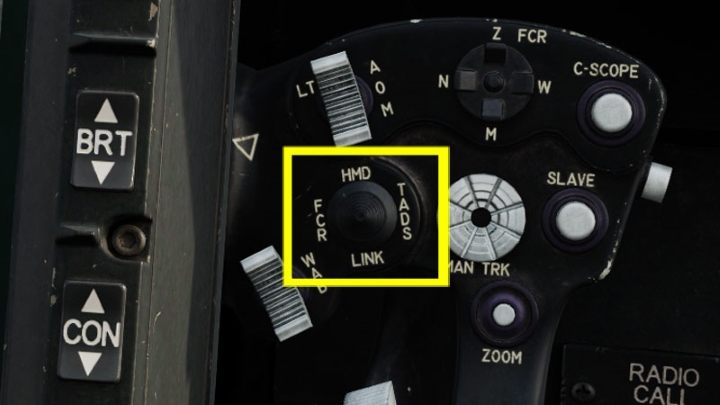
The CPG can switch between the available sights with the Sight Select Switch button on the TADS right grip (RHG). You can choose from:
- Sight Select Switch Right - TADS
- Sight Select Switch Up - HMD
The pilot in the current Early Access version has no alternative, apart from the default P-HMD helmet sight. FCR radar will come later.

The list of available acquisition sources differs, depending on the pilot / CPG seat and the currently selected sight by the CPG.
"SLAVE" button
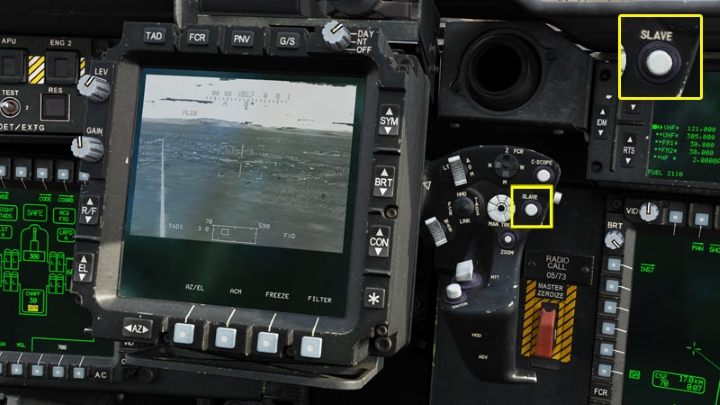
When you operate as CPG, the SLAVE button on the right TEDAC hand grip plays an extremely important role while working with sight and acquisition sources. (NOTE - TEDAC is the name of the TADS screen with both hand grips on the sides). It's exclusive to the CPG cockpit and the gunner uses it each time they want the TADS camera to be automatically slaved to selected point of interest. How does it work?
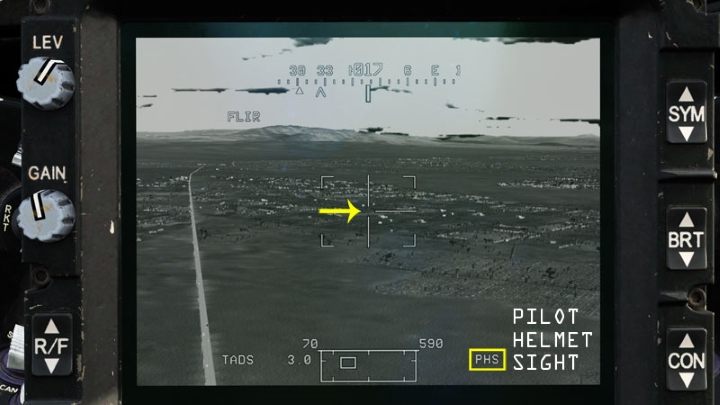
CPG selects TADS as sight source and (for example) Pilot's Helmet Sight as acquisition source. If the pilot notices something in their line of sight and has their helmet sight pointed there, the CPG simply presses the SLAVE button and then the TADS camera automatically aims at the place where the pilot is currently looking. The CPG can then use the camera's capabilities to zoom in, switch to infrared and identify the target, including the ability to fire a missile in that direction.
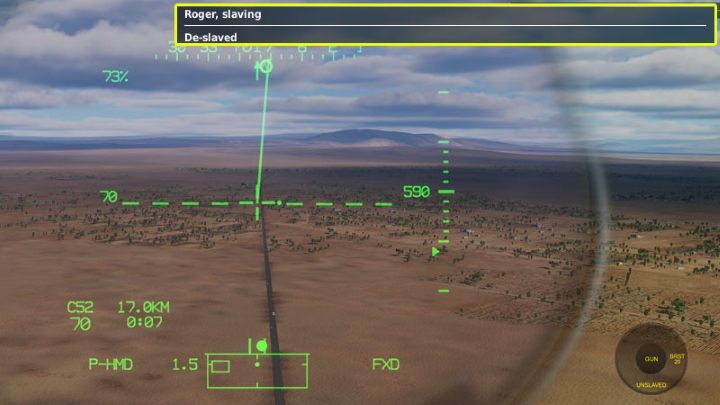
In single-player mode you can experience such a cooperation using George AI Helper as CPG. When you give it order to search the area where your helmet sight is pointed, you will hear "Slaving" - a signal that CPG is pressing the SLAVE button and you should not move your head right now, because the camera needs some time to move. Right after that, it says "de-slave" - the signal that he switched off the SLAVE function, the TADS camera is no longer following the pilot's helmet sight and the pilot can look around freely again. This is what the cooperation between crew members should look like.
Another example is a map point as "acquisition source." The target coordinates entered before arriving at the battle position allow the CPG to set the TADS camera straight at this point well in advance. Just select TADS as sight source and map point as acquisition source. Pressing SLAVE button will immediately aim the TADS camera at the exact point indicated by the coordinates.
SLAVE button - How to use it?
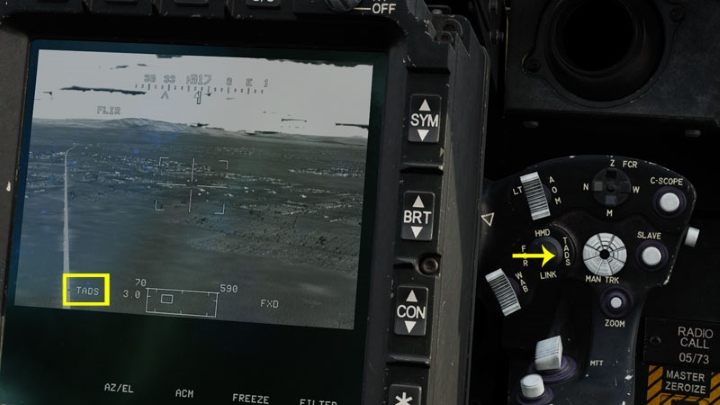
Select TADS as the active sight by pressing Sight Select Switch Right - TADS.
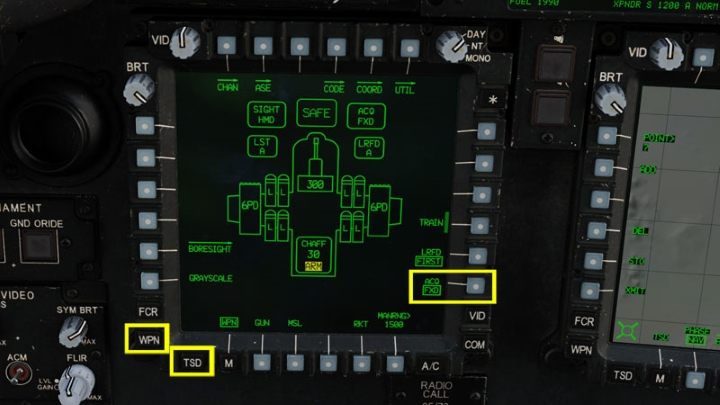
On the WPN or TSD page, select ACQ.
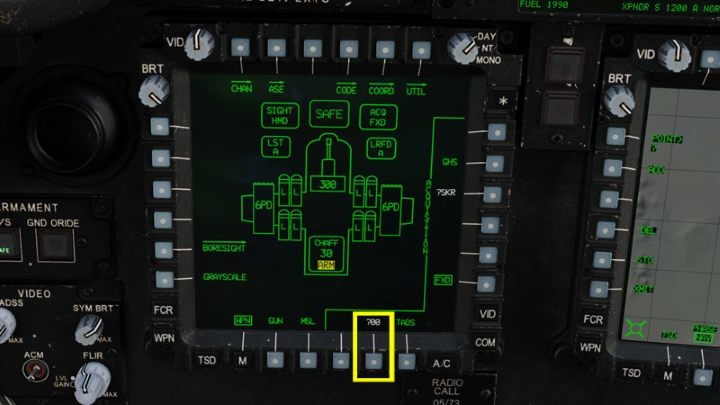
Select the acquisition source from the list of all acquisition sources. In this case, the map point ?00.
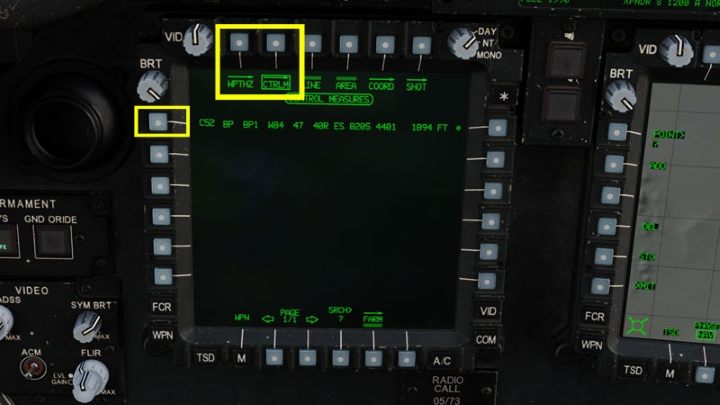
Select the appropriate WPHZ (Waypoints / Hazards) or CTRLM (Control Measures) point category. From the list of available points, select the one to be tracked by TADS. The FREE text descriptions made earlier and categories with the appropriate ID are useful to quickly recognize what a given point means.
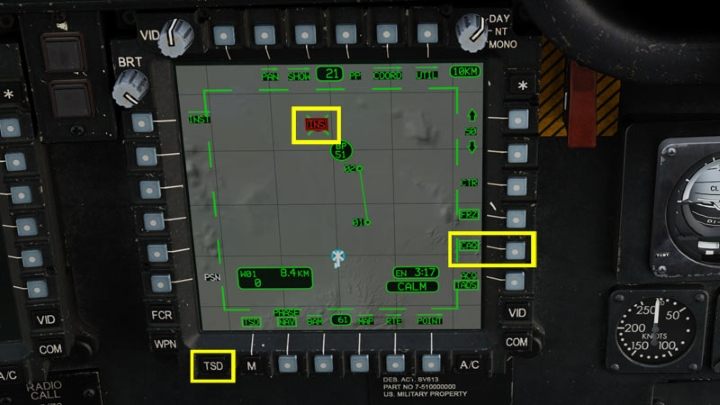
Another, much faster method is using the cursor on the TSD map. Place the cursor on the desired point on the map and select the CAQ option to enable the Cursor Acquisition mode. Now just click Cursor Enter Depress on the selected point. It will automatically become an active acquisition source.
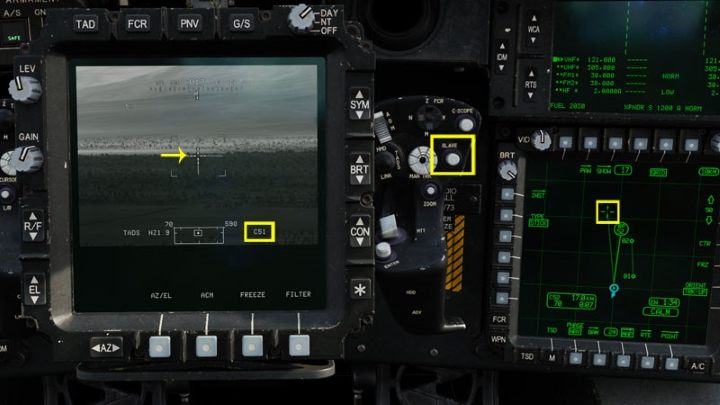
Press SLAVE button on the right grip (RHG) or where you assiged it in control settings. The TADS camera will automatically aim at that point. Press SLAVE again to regain control of the camera.
TADS as Gunner Helmet Sight
A very useful method in the CPG's cockpit is to select own helmet-mounted sight (GHS) as the acquisition source while simultaneously selecting the TADS as active sight. This allows to combine the operation of the helmet sight with the TADS camera after pressing the SLAVE button. Wherever the gunner looks, the camera will also be automatically slaved to, without the need for additional button pressing.
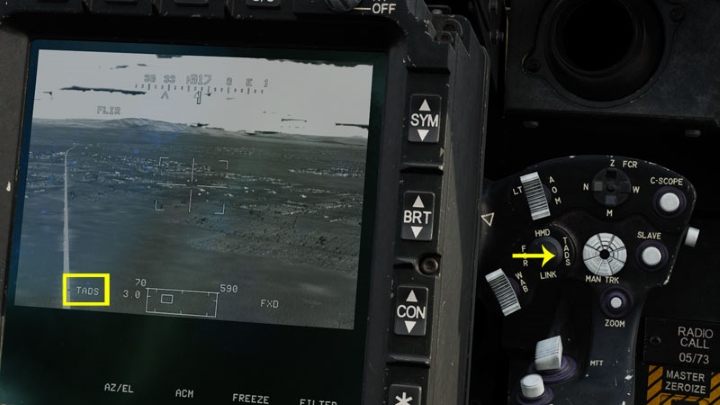
Select TADS as the active sight by pressing Sight Select Switch Right - TADS.
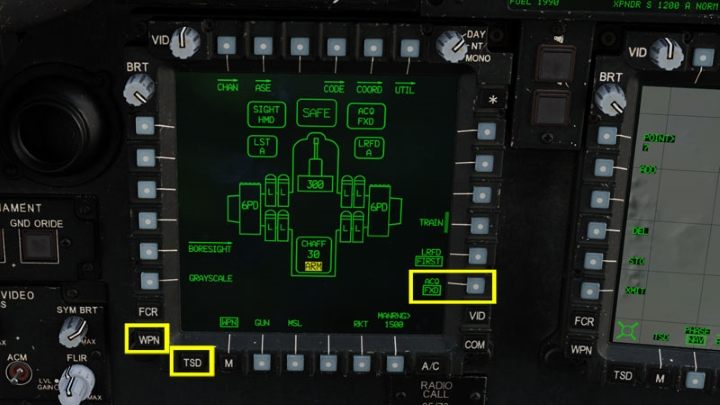
On the WPN or TSD page, select ACQ.

Select GHS - Gunner Helmet Sight - from the list.

Press SLAVE button on the right grip (RHG) or where you assiged it in control settings. If you don't want to see the TADS image mirrored on the IHADSS monocle, turn it off with the "I" key.
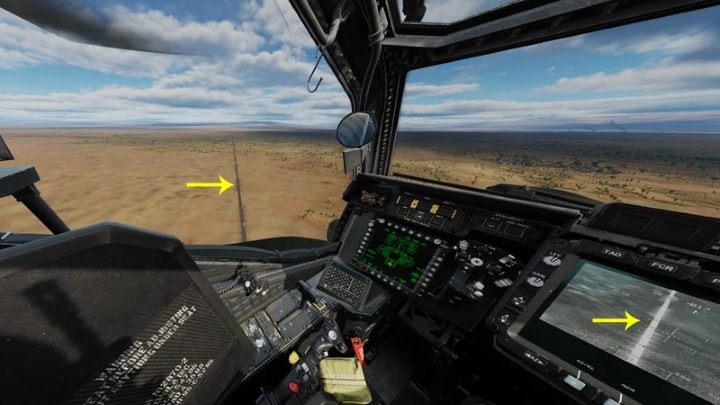
From now on, wherever you look with your helmet sight, the TADS camera will also be aimed. Bear in mind there's a small movement lag on the camera screen - the TADS pod is not able to move as fast as the gunner's head. Press SLAVE button again to disable tracking and stop the TADS camera at the desired location.
Acquisition Source in the pilot's cockpit
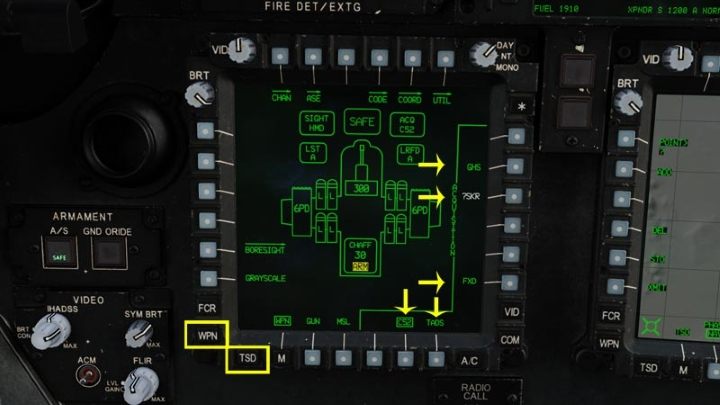
The pilot does not have the TEDAC or the ability to control the TADS camera, therefore the "acquisition" source has a slightly different role here. The source selection, however, looks almost the same. Just click the ACQ button on the WPN or TSD screen, and then choose one of the available options.
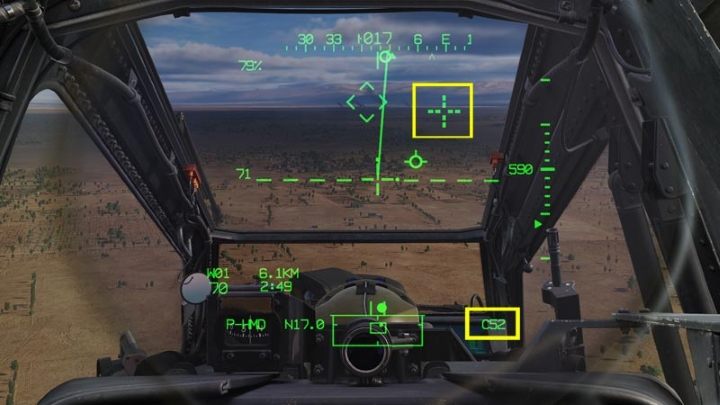
The acquisition source is visible for the pilot as a cross with the dotted lines on the IHADSS. It's called the Cued Line-of-Sight Reticle. It allows the pilot to always see where the selected acquisition source is located. When selecting the GHS (Gunner's Helmet Sight) as acquisition source, it shows where the gunner is currently looking. With TADS as acquisition source, it shows where the TADS crosshair is aimed. With a map point as acquisition source, it shows the location of the selected spot. Cued Line-of-Sight Reticle can be disabled one the WPN -> UTIL -> CUEING screen.

If the acquisition Cued LOS Reticle is outside the IHADSS field of view, the direction to it is shown by the little dots on the LOS Reticle, the so-called Cueing Dots.
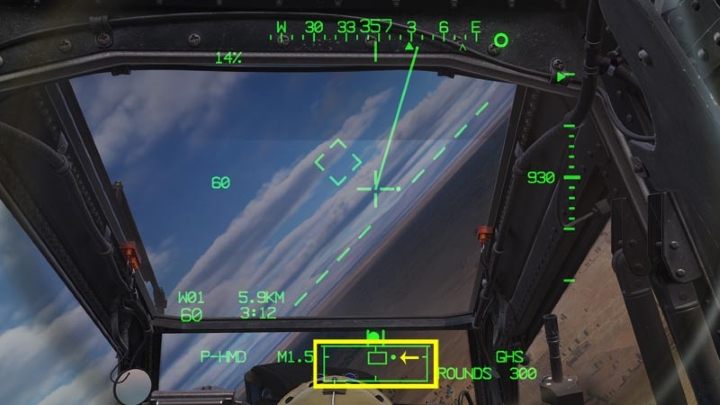
An indication of the current position of the acquisition source is also shown as the Cued Line-of-Sight Dot. A big rectangle box called the Field of Regard is the field of view of the current sensor (e.g. the helmet sight), and the small rectangle in the center called Field-of-View is the field of view of the TADS or PNVS system.

Choosing the pilot's acquisition source is important when attacking with unguided rockets. Depending on whether it is the TADS aimed at the target area or a map point, the Rocket Steering Cursor will behave slightly differently, helping to aim the missiles.
- DCS AH-64 Apache Guide
- DCS AH-64D Apache: Game guide
- DCS AH-64D Apache: Systems and Sensors
- DCS AH-64D Apache: Sight Source and Acquisition Source
- DCS AH-64D Apache: TADS - Target Acquisition and Designation Sight
- DCS AH-64D Apache: PNVS - Pilot Night Vision System - how to use night vision?
- DCS AH-64D Apache: TSD - Tactical Situation Display
- DCS AH-64D Apache: ASE - Aircraft Survivability Equipment
- DCS AH-64D Apache: Radio Communication - how to use radios?
- DCS AH-64D Apache: Systems and Sensors
- DCS AH-64D Apache: Game guide
You are not permitted to copy any image, text or info from this page. This site is not associated with and/or endorsed by the developers and the publishers. All logos and images are copyrighted by their respective owners.
Copyright © 2000 - 2025 Webedia Polska SA for gamepressure.com, unofficial game guides, walkthroughs, secrets, game tips, maps & strategies for top games.
